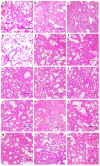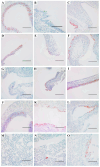Experimental Infection of Rats with Influenza A Viruses: Implications for Murine Rodents in Influenza A Virus Ecology
- PMID: 40284938
- PMCID: PMC12030792
- DOI: 10.3390/v17040495
Experimental Infection of Rats with Influenza A Viruses: Implications for Murine Rodents in Influenza A Virus Ecology
Abstract
Rattus norvegicus (brown rat), a widely distributed rodent and common biomedical model, is a known reservoir for many zoonotic pathogens but has not been traditionally recognized as a host for influenza A virus (IAV). To evaluate their susceptibility, we intranasally inoculated Sprague-Dawley rats with various IAV subtypes, including H5Nx, H7N9, H9N2, H10N8 and the 2009 pandemic H1N1. All strains productively infected the rats, inducing seroconversion without overt clinical signs. While replication efficiency varied, all viruses caused significant lung injury with a preferential tropism for the upper respiratory tract. Investigation of receptor distribution revealed a predominance of α2,3-linked sialic acid (SA) in the nasal turbinates and trachea, whereas α2,6-linked SA was more abundant in the lungs. Notably, both receptor types coexisted throughout the respiratory tract, aligning with the observed tissue-specific replication patterns and broad viral infectivity. These findings demonstrate that rats are permissive hosts for multiple IAV subtypes, challenging their exclusion from IAV ecology. The asymptomatic yet pathogenic nature of infection, combined with the global synanthropy of rats, underscores their potential role as cryptic reservoirs in viral maintenance and transmission. This study highlights the need for expanded surveillance of rodents in influenza ecology to mitigate zoonotic risks.
Keywords: host range; interspecies transmission; sialic acid receptor; surveillance; zoonotic influenza.
Conflict of interest statement
The authors declare no conflicts of interest.
Figures






Similar articles
-
Emergence and Evolution of Novel Reassortant Influenza A Viruses in Canines in Southern China.mBio. 2018 Jun 5;9(3):e00909-18. doi: 10.1128/mBio.00909-18. mBio. 2018. PMID: 29871917 Free PMC article.
-
Heterogeneity across mammalian- and avian-origin A(H1N1) influenza viruses influences viral infectivity following incubation with host bacteria from the human respiratory tract.Microbiol Spectr. 2025 Aug 18:e0097725. doi: 10.1128/spectrum.00977-25. Online ahead of print. Microbiol Spectr. 2025. PMID: 40823861
-
Antigenic Characterization and Pandemic Risk Assessment of North American H1 Influenza A Viruses Circulating in Swine.Microbiol Spectr. 2022 Dec 21;10(6):e0178122. doi: 10.1128/spectrum.01781-22. Epub 2022 Nov 1. Microbiol Spectr. 2022. PMID: 36318009 Free PMC article.
-
Physical interventions to interrupt or reduce the spread of respiratory viruses.Cochrane Database Syst Rev. 2023 Jan 30;1(1):CD006207. doi: 10.1002/14651858.CD006207.pub6. Cochrane Database Syst Rev. 2023. PMID: 36715243 Free PMC article.
-
The global burden of swine influenza and its mitigation.Open Vet J. 2025 May;15(5):1866-1879. doi: 10.5455/OVJ.2025.v15.i5.3. Epub 2025 May 31. Open Vet J. 2025. PMID: 40557091 Free PMC article. Review.
Cited by
-
Progressive Adaptation of Subtype H6N1 Avian Influenza Virus in Taiwan Enhances Mammalian Infectivity, Pathogenicity, and Transmissibility.Viruses. 2025 May 20;17(5):733. doi: 10.3390/v17050733. Viruses. 2025. PMID: 40431744 Free PMC article.
References
-
- World Health Organization (WHO) Global Influenza Programme. [(accessed on 27 February 2025)]. Available online: https://www.who.int/teams/global-influenza-programme/avian-influenza/mon....
Publication types
MeSH terms
Grants and funding
LinkOut - more resources
Full Text Sources

